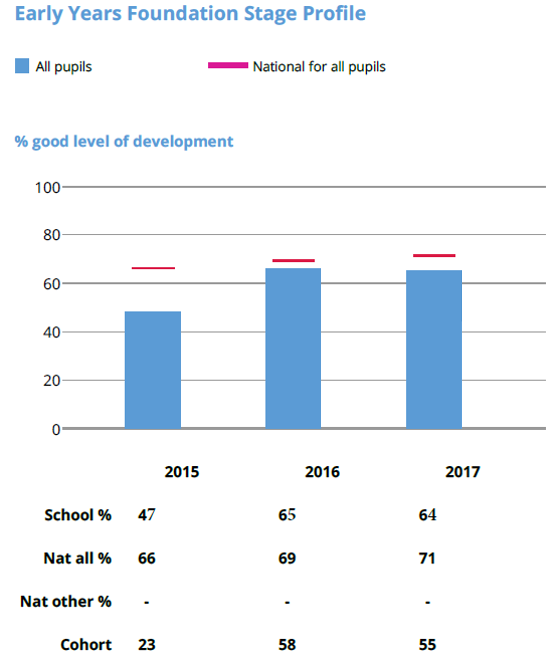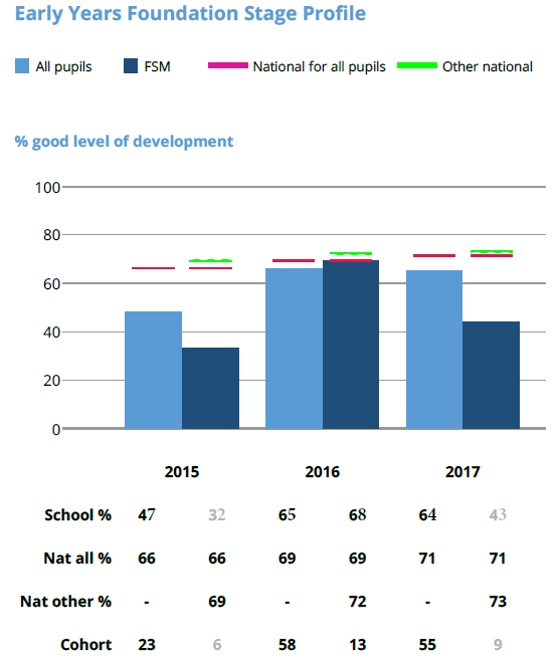
This series of articles will be looking at Ofsted’s Inspection Data Summary Report (IDSR).
This article concentrates on the first of the EYFSP analyses, which is at the back of your IDSR report.
EYFSP (Early Years Foundation Stage Profile)
Good Level of Development (GLD) and ELGs (Early Learning Goals)
There are four different analyses in the EYFSP pages. The article relates to the percentage of pupils achieving a Good Level of Development (GLD). This is one of main measures in EYFSP.
What is a GLD? There are 17 Early Learning Goals (ELGs), and a pupil will obtain a GLD if they get Expected or Exceeding in the first 12, namely:
- Communication and Language (Listening and attention, Understanding, and Speaking),
- Physical Development (Moving and handling, and Health and self-care),
- Personal, Social and Emotional Development (Self-confidence and self-awareness, Managing feelings and behaviour, and Making relationships),
- Literacy (Reading, and Writing), and
- Mathematics (Numbers, and Shape, space and measures).
If a pupil got a single “Emerging” in one of these 12 ELGs, then the pupil will not get a GLD. However, they can get an Emerging in any of the remaining 5 ELGs and it will not affect the GLD, namely:
- Understanding the World (People and communities, The World, and Technology), and
- Expressive arts and Design (Exploring and using media and materials, and Being imaginative).
Good Level of Development – All pupils
The full IDSR chart may look a bit complicated at first, but let’s concentrate on just the lighter blue bars and the red line, as shown above:
- The lighter blue bar shows your school’s attainment over the last 3 years, and
- The red line shows the National average over the last 3 years.
Why is this comparison being made? Paragraph 185 of Ofsted’s School Inspection Handbook states:
185. Inspectors will take account of current standards and progress, including the school’s own performance information, and make a relevant judgement on academic and other learning outcomes for pupils by evaluating the extent to which all pupils… achieve or exceed standards expected for their age nationally (at the end of a key stage)...
Good Level of Development – FSM pupils

Looking at the darker blue bars, the red line and the green line:
- The darker blue bar shows the attainment of your school’s Free School Meal (FSM) pupils over the last 3 years,
- The red line shows the National average for all pupils over the last 3 years, and
- The green line shows the National average for non-FSM pupils over the last 3 years.
Why is your school’s FSM performance being compared with the National non-FSM performance?
Paragraphs 192 and 193 of the School Inspection Handbook says this about disadvantaged pupils:
192. Inspectors will take particular account of the progress made by disadvantaged pupils from their starting points. They will consider the progress made by the end of the key stage compared with that made nationally by other pupils with similar starting points. …
The phrase “other pupils” means non-disadvantaged pupils – for EYFSP, this would be non-FSM pupils.
193. For current pupils, inspectors will consider the impact of what a school is doing to reduce any differences in progress and attainment between disadvantaged and other pupils with the same starting points. …

In our ASaP report (Analyse School Performance Made Easy), we present your Early Years’ data for All Pupils, Boys, Girls, FSM and non-FSM pupils, including summarizing data in plain English.
Small cohort size
These percentages are also shown beneath the chart, together with the cohort size. Why is the cohort size important? Ofsted’s handbook says:
192. …Inspectors must review carefully what data is meaningful and avoid focusing on the performance of small groups where assessment information is less reliable.
193. …Where performance information is limited due to small group size, inspectors should gather a wide range of other evidence to ensure the school is providing effectively for disadvantaged pupils, including reviewing pupils’ work, and talking to pupils and teachers.
But what is a “small group size”? Ofsted has defined it as:
- If you are looking at just one year’s results, then Ofsted will not comment separately on any cohort less than 11 pupils. Ofsted shows this by putting the results and cohort size in grey.
- If you are looking at a trend (i.e. two years’ results or more), then Ofsted will not comment separately on any cohort where any year has under 6 pupils.
More information about the EYFSP National and LA averages can be found on the gov.uk website.
In the next article, we’ll be looking at the remaining EYFSP analyses, and the Phonics analysis.
This FREE training course is also Available for FREE as a video learning course on our YouTube Channel.
- Learn at your speed (can be paused and restarted)
- Use on the go (over internet)
- Great for School Governors and School Leaders
